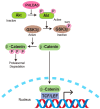The Role of PHLDA3 in Cancer Progression and Its Potential as a Therapeutic Target
- PMID: 40227573
- PMCID: PMC11988131
- DOI: 10.3390/cancers17071069
The Role of PHLDA3 in Cancer Progression and Its Potential as a Therapeutic Target
Abstract
Pleckstrin homology-like domain family A, member 3 (PHLDA3) is a p53-regulated tumor suppressor protein that suppresses AKT-mediated survival and oncogenic signaling. The PHLDA3 gene has garnered significant attention due to its multifaceted roles in tumorigenesis, metastasis, and invasion. This review explores the complex interactions between PHLDA3 and key cellular processes involved in cancer, emphasizing its regulatory mechanisms and clinical relevance. PHLDA3 has been found to be a critical regulator of metastatic pathways, particularly through its influence on the epithelial-mesenchymal transition (EMT) and in cellular invasion. Its interactions with pivotal signaling pathways, such as the Phosphoinositide 3-kinases/Protein kinase B (PI3K/AKT), p53, and Wnt/β-catenin pathways, highlight its multifunctional roles in various cancer types. Additionally, we discuss the potential of PHLDA3 as both a prognostic biomarker and a therapeutic target, offering new insights into its potential in treating advanced-stage malignancies. This review provides a detailed analysis of the role of PHLDA3 in cancer progression, including metastasis and invasion, underscoring its therapeutic potential.
Keywords: AKT pathway; PHLDA3; invasion; metastasis; p53; tumor progression.
Conflict of interest statement
The authors declare no potential conflicts of interest.
Figures





Similar articles
-
PHLDA3 exerts an antitumor function in prostate cancer by down-regulating Wnt/β-catenin pathway via inhibition of Akt.Biochem Biophys Res Commun. 2021 Sep 24;571:66-73. doi: 10.1016/j.bbrc.2021.07.038. Epub 2021 Jul 22. Biochem Biophys Res Commun. 2021. PMID: 34303965
-
Pleckstrin homology-like domain family A, member 3, a miR-19a-3p-regulated gene, suppresses tumor growth in osteosarcoma by downregulating the Akt pathway.Bioengineered. 2022 Feb;13(2):3993-4009. doi: 10.1080/21655979.2022.2031404. Bioengineered. 2022. PMID: 35112982 Free PMC article.
-
PHLDA3 activated by BARX2 transcription, suppresses the malignant development of esophageal squamous cell carcinoma by downregulating PI3K/AKT levels.Exp Cell Res. 2023 May 15;426(2):113567. doi: 10.1016/j.yexcr.2023.113567. Epub 2023 Mar 23. Exp Cell Res. 2023. PMID: 36965748
-
p53-PHLDA3-Akt Network: The Key Regulators of Neuroendocrine Tumorigenesis.Int J Mol Sci. 2020 Jun 8;21(11):4098. doi: 10.3390/ijms21114098. Int J Mol Sci. 2020. PMID: 32521808 Free PMC article. Review.
-
SPOCK1 Involvement in Epithelial-to-Mesenchymal Transition: A New Target in Cancer Therapy?Cancer Manag Res. 2020 May 18;12:3561-3569. doi: 10.2147/CMAR.S249754. eCollection 2020. Cancer Manag Res. 2020. PMID: 32547193 Free PMC article. Review.
References
-
- Siegel R.L., Giaquinto A.N., Jemal A. Cancer statistics, 2024. CA Cancer J. Clin. 2024;74:12–49. - PubMed
-
- Ferlay J., Colombet M., Soerjomataram I., Parkin D.M., Piñeros M., Znaor A., Bray F. Cancer statistics for the year 2020: An overview. Int. J. Cancer. 2021;149:778–789. - PubMed
-
- Ma S., Quan P., Yu C., Fan X., Yang S., Jia W., Yang X. PHLDA3 exerts an antitumor function in prostate cancer by down-regulating Wnt/β-catenin pathway via inhibition of AKT. Biochem. Biophys. Res. Commun. 2021;571:66–73. - PubMed
Publication types
Grants and funding
LinkOut - more resources
Full Text Sources
Research Materials
Miscellaneous

